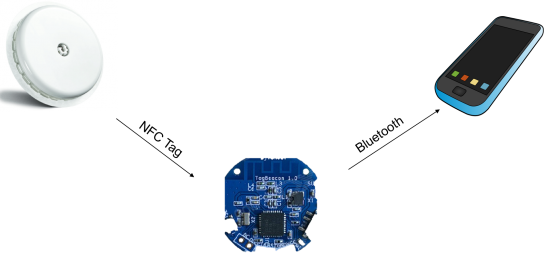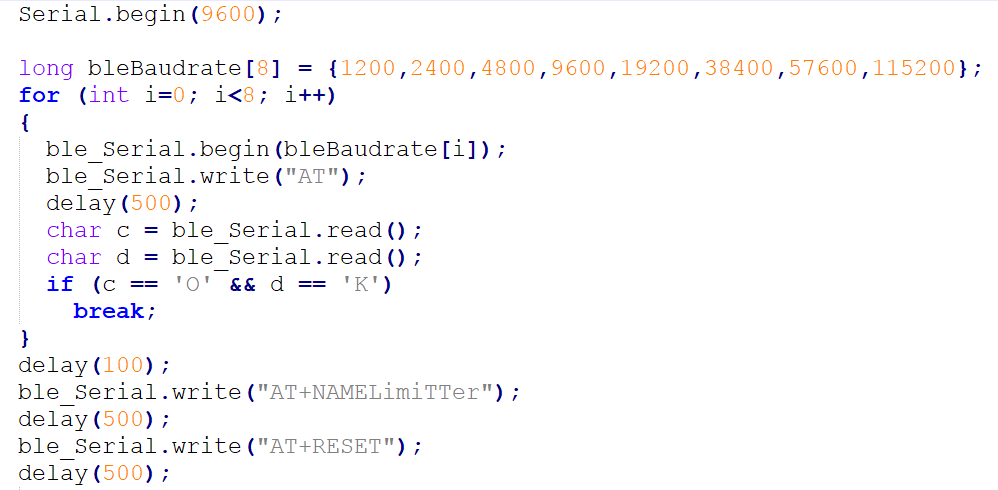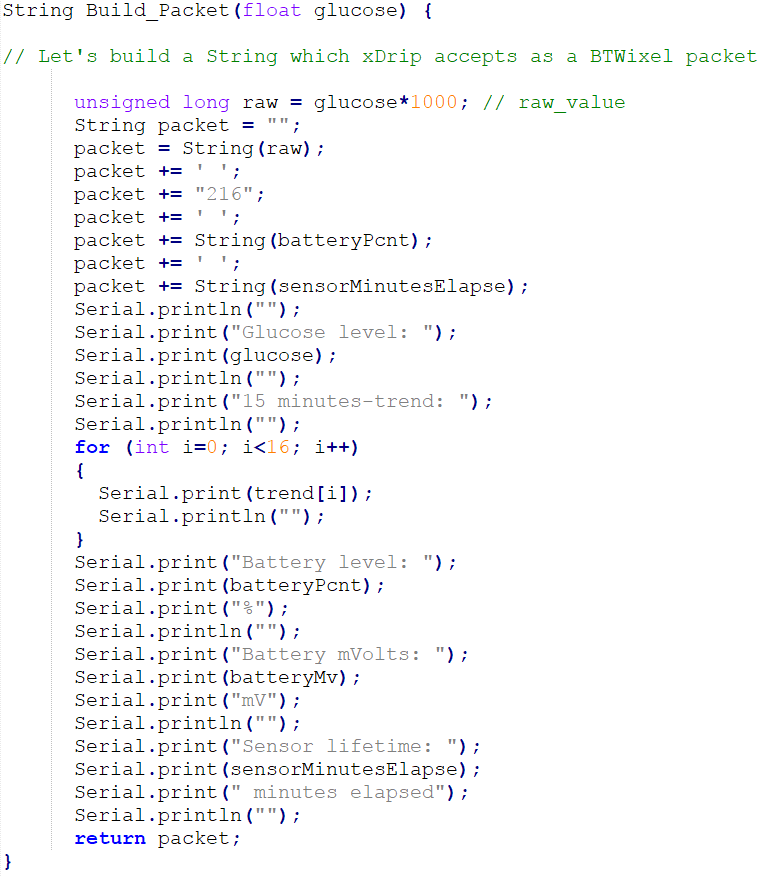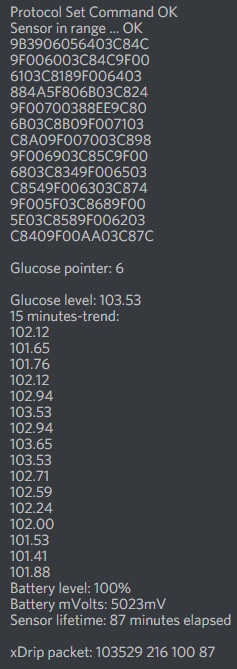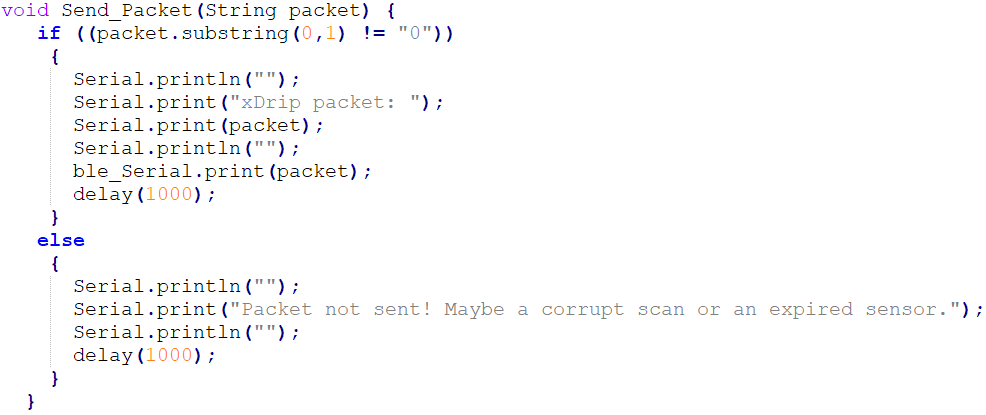Difference between revisions of "Projects:2017s1-156 Interrogating a Glucose Monitor"
(→Bluetooth) |
|||
| Line 21: | Line 21: | ||
Vcc and GND pins provide the power. | Vcc and GND pins provide the power. | ||
[[File:HM-13.jpg]] | [[File:HM-13.jpg]] | ||
| + | |||
HM-13 | HM-13 | ||
| + | |||
After checking with HM-13’s data sheet, we discovered that connect pin 15 of HM-13 can improve battery lifetime. | After checking with HM-13’s data sheet, we discovered that connect pin 15 of HM-13 can improve battery lifetime. | ||
| + | |||
| + | ==Set up correct Baud Rate== | ||
| + | |||
| + | The default setting for the BLE connection baud rate is 9600. In case this rate value is not recognizable, the for loop will try all 8 possibilities and set the correct value once it reads an “OK” response. | ||
| + | Once the device is turned on, the wakeup function will call ‘restartBLE’ function to deliver the stored data in “HIGH” variable. | ||
| + | |||
| + | [[File:Set_up_baud_rate.png]] | ||
| + | |||
| + | ==Build Bluetooth Packet== | ||
| + | |||
| + | This is the most critical part of the project since it will transfer the data collected from NFC modules and send the measurement to the mobile phone. This process is like how the cargo transfers intermodal containers between harbours. A packet shall be created to let the xDrip application accept following the BTWixel packet which is the uniformed format containing all required criteria by the application. The packet includes current glucose value, current battery percentage, sensor minutes elapse, glucose trend (15-minutes trend), current battery level and in mV. | ||
| + | |||
| + | [[File:Build_up_bluetooth_packet.png]] | ||
| + | |||
| + | [[File:Output_of_raw_NFC_readings_and_converted_Bluetooth_packet.png]] | ||
| + | |||
| + | Output of raw NFC readings and converted Bluetooth packet | ||
| + | |||
| + | ==Bluetooth Data Transfer== | ||
| + | |||
| + | After gathering all required variables in the Packet string, the program calls “send packet” function to send these values to the mobile phone. It also checks the status of this process and returns whether it is a success or not. If the transmitting process failed, "Packet not sent! Maybe a corrupt scan or an expired sensor." will be displayed. | ||
| + | |||
| + | [[File:BT_data_transfer.png]] | ||
== Group Members == | == Group Members == | ||
Revision as of 00:20, 30 October 2017
Contents
Introduction
The purpose of this project is to interrogate the commercially available product of flash glucose monitoring by building a wearable device. The importance of continuous glucose monitoring is to maintain the normal glucose tolerance in the human body. It would be useful for people who face life-threatening diabetes symptoms since if the diabetic patients take inappropriate actions without knowing their real-time blood sugar would result in losing their life. For this project, we choose the Freestyle Libre company’s glucose monitoring device. We build a wearable device that provides users with the ability to get the readings at any time on their phone rather than using another company’s own-designed monitor reader equipment. The application installed on users’ phone will display the data on their screen and store the readings in a remote server to allow them to access the information from different devices.
Freestyle Libre Flash Glucose Monitoring System
This product consists of two parts, sensor and reader. Both are communicated via NFC which means the reader need to be close enough to interact with sensor. The sensor is small and lightweight. Thus, it is also a water-resistant. It is designed to be worn for up to 14 days and it need to be applied on the back of the upper arm. When sensor is applied, a thin, flexible and sterile fibre is inserted just under the skin. Sensor dimensions is 35mm x 5mm and its weight is 5 grams. It has memory to store the data up tp eight hours.
Design
Near Field Communication
Near Field Communication (NFC) Technology is used to collect the data from the sensor
Bluetooth
The team decided to use HM-13 as our Bluetooth module since its dimensions suiting our project, 1.7 mm * 27 mm * 13mm, 0.8 grams. It supports Bluetooth 4.1 connectivity with 2~8 Kb/s transferring rate. 4 pins will be used to utilize this module, Rx, Tx, Vcc, GND.
The Rx and Tx pins connect to the main chip board for transmitting signal.
Vcc and GND pins provide the power.
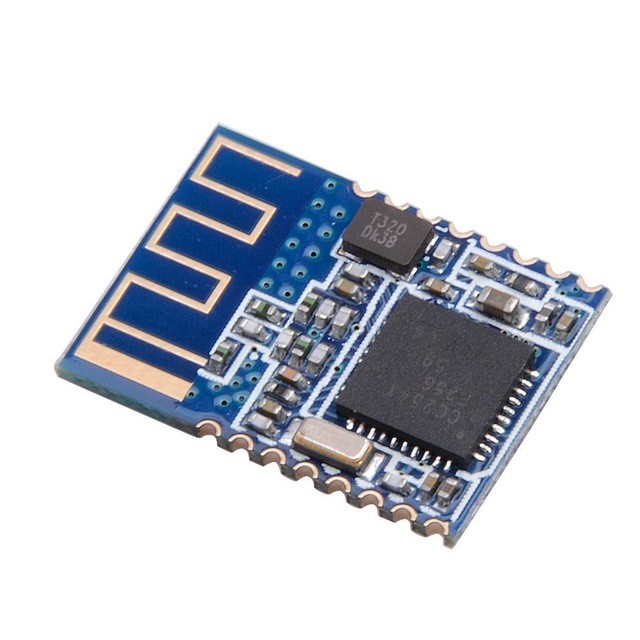
HM-13
After checking with HM-13’s data sheet, we discovered that connect pin 15 of HM-13 can improve battery lifetime.
Set up correct Baud Rate
The default setting for the BLE connection baud rate is 9600. In case this rate value is not recognizable, the for loop will try all 8 possibilities and set the correct value once it reads an “OK” response. Once the device is turned on, the wakeup function will call ‘restartBLE’ function to deliver the stored data in “HIGH” variable.
Build Bluetooth Packet
This is the most critical part of the project since it will transfer the data collected from NFC modules and send the measurement to the mobile phone. This process is like how the cargo transfers intermodal containers between harbours. A packet shall be created to let the xDrip application accept following the BTWixel packet which is the uniformed format containing all required criteria by the application. The packet includes current glucose value, current battery percentage, sensor minutes elapse, glucose trend (15-minutes trend), current battery level and in mV.
Output of raw NFC readings and converted Bluetooth packet
Bluetooth Data Transfer
After gathering all required variables in the Packet string, the program calls “send packet” function to send these values to the mobile phone. It also checks the status of this process and returns whether it is a success or not. If the transmitting process failed, "Packet not sent! Maybe a corrupt scan or an expired sensor." will be displayed.
Group Members
Hui Wang
Wan Muhammad Che Mustafa
Supervisors
Prof. Mathias Baumert
Dr. Said Al-Sarawi
References
[1] "Diabetes in Australia", Diabetesaustralia.com.au, 2017. [Online]. Available: https://www.diabetesaustralia.com.au/diabetes-in-australia. [Accessed: 24- Oct- 2017].
[2] "Diabetes", World Health Organization, 2017. [Online]. Available: http://www.who.int/mediacentre/factsheets/fs312/en/. [Accessed: 25- Oct- 2017].
[3] W. Organization, Global Report On Diseases 2016. France: World Health Organization, 2016, pp. http://apps.who.int/iris/bitstream/10665/204871/1/9789241565257_eng.pdf.
[4] H. Information, D. Overview, P. Problems, L. (Hypoglycemia), L. (Hypoglycemia), T. Center and N. Health, "Low Blood Glucose (Hypoglycemia) | NIDDK", National Institute of Diabetes and Digestive and Kidney Diseases, 2017. [Online]. Available: https://www.niddk.nih.gov/health-information/diabetes/overview/preventing-problems/low-blood-glucose-hypoglycemia. [Accessed: 20- Apr- 2017].
[5] F. Sensor and F. Reader, "Flash Glucose Meters & Monitoring Systems Online in Australia", FreeStyleLibre.com.au, 2017. [Online]. Available: https://www.freestylelibre.com.au/. [Accessed: 21- Apr- 2017].
[6] "FreeStyle Libre Reader - Buy Online", Freestylelibre.co.uk, 2017. [Online]. Available: https://www.freestylelibre.co.uk/libre/products/reader.html. [Accessed: 21- Apr- 2017].
[7] "UPetersen/LibreMonitor", GitHub, 2016. [Online]. Available: https://github.com/UPetersen/LibreMonitor. [Accessed: 21- Apr- 2017].
[8] "JoernL/LimiTTer", GitHub, 2016. [Online]. Available: https://github.com/JoernL/LimiTTer. [Accessed: 21- Apr- 2017].
[9] Wiki.seeedstudio.com. (2017). Xadow - Wiki. [online] Available at: http://wiki.seeedstudio.com/wiki/Xadow [Accessed 1 Jun. 2017].
[10] "NFC Tools", Play.google.com, 2017. [Online]. Available: https://play.google.com/store/apps/details?id=com.wakdev.wdnfc&hl=en. [Accessed: 01- Jun- 2017].
[11] Librelink.com, 2017. [Online]. Available: https://www.librelink.com/ [Accessed: 01- Jun- 2017].
[12] BM019 Serial to NFC Converter - Serial Data to Near Field Communication Converter. Chico: Solutions Cubed, 2013, p. 20.
